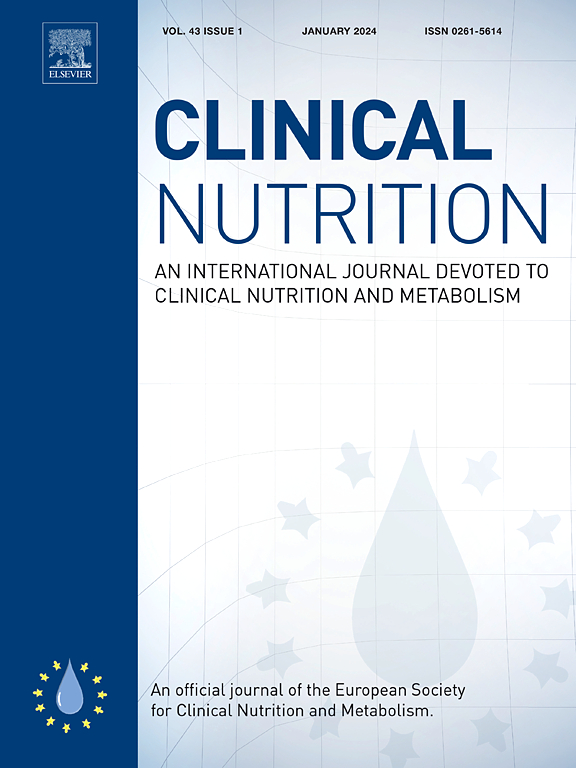Increasing plant protein in the diet induces changes in the plasma metabolome that may be beneficial for metabolic health. A randomized crossover study in males
IF 6.6
2区 医学
Q1 NUTRITION & DIETETICS
引用次数: 0
Abstract
Background & aim
Dietary shifts replacing animal protein (AP) with plant protein (PP) sources have been associated with lowering cardiometabolic risk (CMR), but underlying mechanisms are poorly characterized. This nutritional intervention aims to characterize the metabolic changes induced by diets containing different proportions of AP and PP sources in males at CMR.
Design
This study is a 4-week, crossover, randomized, controlled-feeding trial in which 19 males with CMR followed two diets providing either 36 % for the control diet (CON-D) or 64 % for the flexitarian diet (FLEX-D) of total protein intake from PP sources. Plasma nontargeted metabolomes (LC-MS method) were measured in the fasted state and after a high-fat challenge meal at the end of each intervention arm. Lipogenesis and protein synthesis fluxes, flow-mediated dilatation (FMD) and gluco-lipidic responses were assessed after the challenge meal. Data were analyzed with mixed models, and univariate and multivariate models for metabolomics data.
Results
In both arms CMR improved with time, with decreased body weight (−0.9 %), insulin resistant (−34 %, HOMA-IR, Homeostatic Model Assessment for Insulin Resistance) and low-density lipoproteins (LDL)-cholesterol (−11 %). Diet had no effect on FMD or metabolic fluxes, but a trend (0.05 < p ≤ 0.1) was observed for a stronger decrease in HOMA-IR and lower postprandial glucose after FLEX-D vs CON-D. The abundance of 21 and 37 metabolites differed between diets at fasted and fed states, respectively, including food intake biomarkers of AP (methylhistidine, eicosapentaenoic acid, hydroxyprolines) and PP sources (trigonelline, N-acetyl-ornithine). In fasted or fed states, indole acrylic acid and indole propionic acid, both products of tryptophan catabolism, were higher after FLEX-D vs CON-D, while the indispensable amino acids-related metabolites alpha-aminoadipic acid, hydroxymethylbutyric acids and propionylcarnitine were lower. In the postprandial state only, the ω-oxidation products dodecanedioic, tetradecanedioic and hexadecanedioic acids were higher after FLEX-D vs CON-D.
Conclusions
Despite little changes in risk factors after 4 wk, this study evidenced subtle metabolic adaptations in amino acids and lipid metabolism and gut microbiota activity occurring after higher PP source intake that may be beneficial to CMR.
Clinicaltrials.gov study identifier
NCT04236518.
Clinical trial registry
NCT04236518 on ClinicalTrials.gov.
增加饮食中的植物蛋白可诱导血浆代谢组发生变化,从而有益于代谢健康。一项针对男性的随机交叉研究。
背景和目的:以植物蛋白(PP)替代动物蛋白(AP)的膳食结构调整与降低心脏代谢风险(CMR)有关,但其潜在机制尚不十分明确。这项营养干预研究旨在确定含有不同比例 AP 和 PP 来源的膳食对处于 CMR 的男性所引起的代谢变化的特征:本研究是一项为期 4 周的交叉、随机、对照喂养试验,19 名患有 CMR 的男性遵循两种饮食,对照饮食(CON-D)的蛋白质摄入量占总蛋白质摄入量的 36%,灵活饮食(FLEX-D)的蛋白质摄入量占总蛋白质摄入量的 64%。血浆非目标代谢组(LC-MS 方法)是在空腹状态下以及在每个干预组结束时的高脂挑战餐后测定的。挑战餐后评估了脂肪生成和蛋白质合成通量、血流介导的扩张(FMD)和糖脂反应。数据采用混合模型以及代谢组学数据的单变量和多变量模型进行分析:结果:随着时间的推移,两组患者的CMR均有所改善,体重(-0.9%)、胰岛素抵抗(-34%,HOMA-IR,胰岛素抵抗静态模型评估)和低密度脂蛋白胆固醇(-11%)均有所下降。饮食对 FMD 或代谢通量没有影响,但有趋势(0.05 结论):尽管4周后风险因素变化不大,但这项研究证明,在摄入更多PP来源后,氨基酸和脂质代谢以及肠道微生物群活动会发生微妙的代谢适应性变化,这可能对CMR有益:Gov 研究标识符:NCT04236518.临床试验登记:临床试验登记:NCT04236518 on ClinicalTrials.gov。
本文章由计算机程序翻译,如有差异,请以英文原文为准。
求助全文
约1分钟内获得全文
求助全文
来源期刊

Clinical nutrition
医学-营养学
CiteScore
14.10
自引率
6.30%
发文量
356
审稿时长
28 days
期刊介绍:
Clinical Nutrition, the official journal of ESPEN, The European Society for Clinical Nutrition and Metabolism, is an international journal providing essential scientific information on nutritional and metabolic care and the relationship between nutrition and disease both in the setting of basic science and clinical practice. Published bi-monthly, each issue combines original articles and reviews providing an invaluable reference for any specialist concerned with these fields.
 求助内容:
求助内容: 应助结果提醒方式:
应助结果提醒方式:


